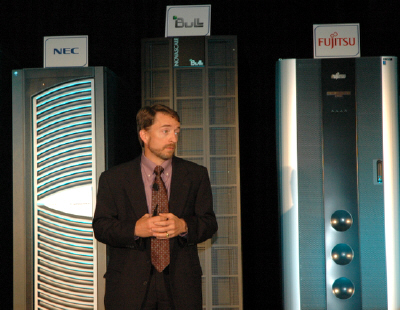Dual-Core Itanium 2 lifts off

The San Francisco Four Seasons hotel was the scene for Intel's launch of "Montecito," the first dual-core version of the Itanium processor. Pat Gelsinger, senior vice president of Intel's Digital Enterprise Group, backed on stage by eight tons of big Duo-Core Itanium 2 iron from OEM launch partners, touted the raw performance, software support, reliability, Hyperthreading, security and cost benefits of the new 9000 processor family. He described the Duo-Core Itanium 2 as allowing the "freedom to choose a new mission critical computing architecture," giving a jab to the RISC-based chip architectures from Sun and IBM.

Video: Pat Gelsinger talks about market for the Duo-Core Itanium 2 processors
The mega-chip has 1.72 billion transistors. Gelsinger said he was employee number one at Intel on the 486 project, which had 1.1 million transistors and first shipped in 1989--Moore's Law at work. Gelsinger said that the Duo-Core Itanium 2 doubles the performance of the previous generation, offers a 20-percent reduction in power consumption and improves performance per watt by a factor of 2.5.
"Software is no longer an issue," Gelsinger told me. "We have everything you'd want...I think it's better for Itanium than any other high-end architecture [Sun's SPARC and IBM's Power] at this point ," he added. He cited 8,200 applications from 1,000 different companies, including the major ERP and CRM applications and databases. "It's all the things you care about, and you end up with HPC apps as well, and a lot of the filler apps of an enterprise stack," Gelsinger said.
During the launch event, Larry Lozon, vice president of EDS's data center services, said that he had seen 83 percent improvement in CICS Cobal proof-of-concept applications. "We have arrived at a focal point where sizable MIP capacity will move platforms for the first time in history," Lozon said.
Even with the Duo-Core Itanium 2 now in play, speculation about the future of the Itanium hasn't dimmed. Don Clark asked a Wall Street Journal [subscription required ] story about Intel's commitment to Itanium:
Recent financial pressures on Intel -- which has launched a cost-cutting campaign -- have prompted speculation that the company might sell or shut down the Itanium effort. Intel plays down that possibility. "Everything is on the table" in the way of cost-cutting moves, said Bill Kircos, a spokesman for Santa Clara, Calif., company. "But we have three generations of Itanium on tap after Montecito."
Sales for the previous generation of Itanium have not been stellar. According to IDC, 8,182 Itanium-based systems were sold in the first quarter, less than first quarter of 2005, although Gelsinger noted that IDC's numbers showed strong revenue growth compared to Sun and IBM in the space.
Gelsinger said he expects that having OEMs shipping, beyond HP, will allow Intel to capture a good share of the $25 billion mission critical computing market. "The big mainframe companies are in production with mission critical platforms, we have application momentum and end users are putting in deployments and saying, 'Hey, this thing rocks.' Ultimately we will win in the mission critical computing, RISC replacement and HPC space," Gelsinger said. He is also betting that the Itanium Solutions Alliance (ISA), funded mostly by Intel and HP, will get something out of the supposed $10 billion the consortium plans to spend through 2010 to drive Itanium adoption.